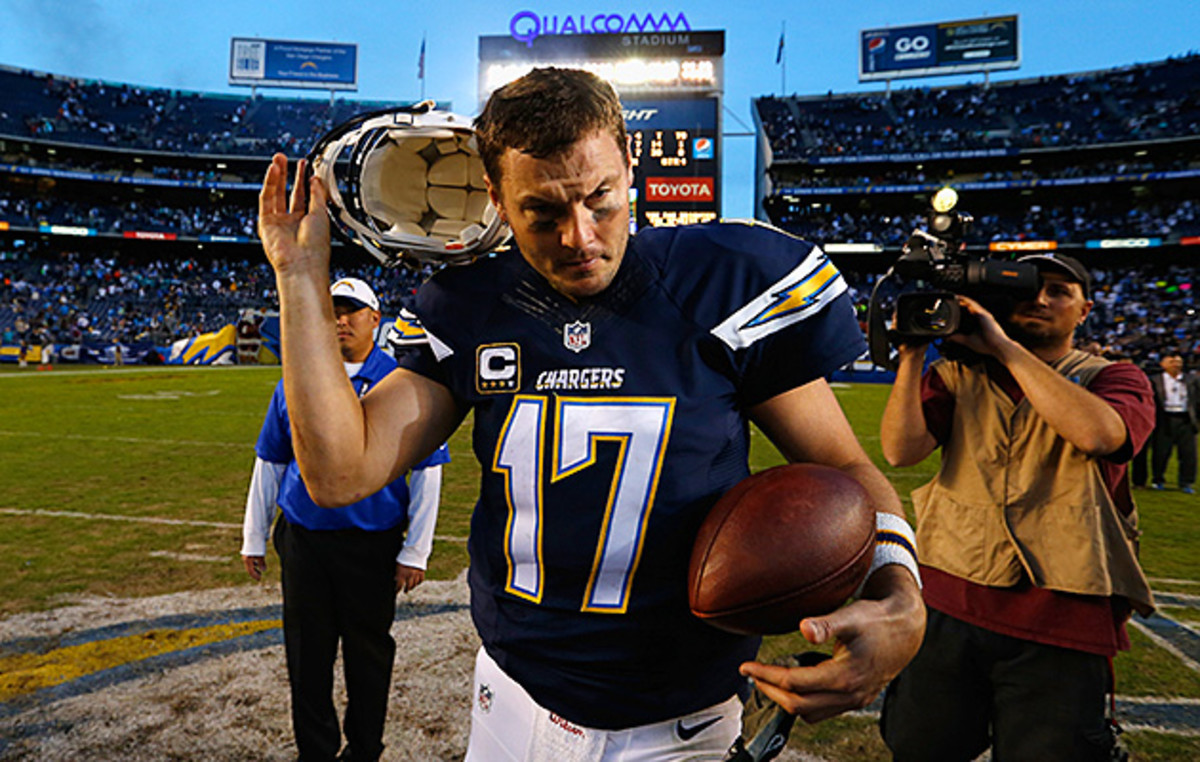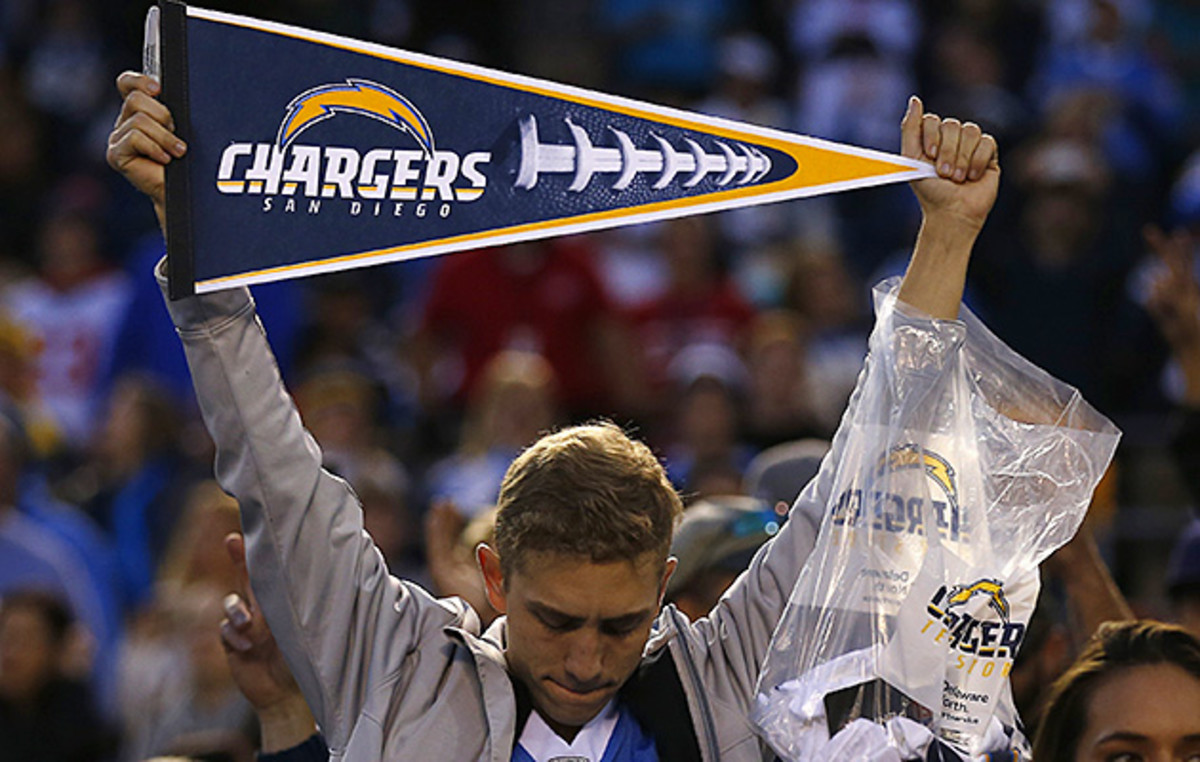A Beautiful Funeral: Scenes from Chargers' possible final home game

SAN DIEGO — My first Chargers game was on Sept. 21, 1986, and their 18-point lead was down to four with two minutes left. I was nine years old, standing above the west end zone at Jack Murphy Stadium with my dad and my foam finger, and Redskins receiver Gary Clark was improvising routes because he couldn’t hear the play calls. Despite the din, Washington marched 69 yards in 44 seconds, and Clark split two defenders for the game-winning touchdown. “I feel sorry for San Diego,” Redskins coach Joe Gibbs said afterward.
Eric Weddle lays down at midfield after possible last game in San Diego
My last Chargers game, if the owner has his way, was Sunday, December 20, 2015. More than 66,000 people showed up. Carolers sang in the concourse before kickoff. Three hundred young cheerleaders danced on the field at halftime. The Chargers rolled the Dolphins, 30–14, and “Stay Just a Little Bit Longer” blared over the loudspeaker. It was a beautiful funeral. Quarterback Philip Rivers choked up in the huddle. Safety Eric Weddle cried in the end zone. Some players lingered until 6 p.m., while fans belted out “San Diego Super Chargers,” a disco dirge. “We’re 4–10, we’re 4–10, we’re 4–10,” Rivers kept telling himself, “and they act like it’s the playoffs.” He stood at his locker in his socks, having handed both cleats to strangers, along with his cap. “Football is more than wins and losses here,” he said. “It’s community.”
On Jan. 13 in Houston, NFL owners will vote on two stadium proposals to fill the longstanding void in the Los Angeles market, one that would send the Rams to Inglewood, the other that would dispatch the Chargers and Raiders to Carson. The specter of the vote has paralyzed three fan bases, and they all deserve sympathy, but excuse me while I raise my old foam finger for the city that supported its team through a half-century without a championship, the one that drew 150,000 people to a Super Bowl parade after a loss, the one that mounted a public protest when the organization decided to open the parking lot five hours before kick instead of seven. Drivers accustomed to lining up on Friars Road at 4 a.m. hung team officials in effigy.
My hometown is not Green Bay or Kansas City or Dallas, but it doesn’t need a tarp to cover the upper deck, either. This season, the Chargers ranked 19th in attendance, the Raiders 30th and the Rams 32nd. Last year, they ranked 16th in local TV ratings, the Rams 27th and the Raiders 32nd. When the Chargers were good, from 2004-09, they sold out every home game and drew another 10,000 for rallies after road wins. Once, when the Bolts returned from a playoff victory in Indianapolis, team buses had to stop on the way to their Murphy Canyon facility because so many people swarmed Aero Drive.
Since the Spanos family bought the Chargers in 1984, they only advanced past the divisional round twice. They fired a coach who went 14–2 and retained one who went 1–15. They drafted Ryan Leaf and bid goodbye to Drew Brees. But the community never turned. The team’s blood drive broke the Guinness world record for the largest single-day donation. The football camp drew as many as 14,000 kids a year. The city government agreed for nearly a decade to buy every ticket that went unsold.

Of course, pep rallies and blood drives don’t build stadiums, and Chargers owner Dean Spanos swears he has tried in vain for 15 years to negotiate a deal in San Diego. But for all the time the Chargers supposedly devoted to their stadium search, they never submitted a formal proposal or financing plan. In their defense, San Diego was on the brink of bankruptcy in the mid-2000s, and Spanos couldn’t have struck a deal even if he were serious. In 2004, The New York Times famously termed the city Enron-by-the-Sea, and six mayors later, Chargers’ stadium strategist Mark Fabiani is still trying to keep that outdated image alive. Fabiani, best known in the sports world for representing Lance Armstrong, has portrayed San Diego government leadership as “unsophisticated” and “unsuccessful”—or worse.
“At one time half the council went to jail,” Texans owner Bob McNair, a member of the NFL’s committee for Los Angeles opportunities, said last week. “It’s hard to negotiate when you’ve got to go to the jail.” Apparently, billionaires need fact checkers, too. One San Diego city council member spent 15 months in prison from 2012-13—seven years after he resigned from office.
In August, San Diego mayor Kevin Faulconer announced a proposal in which the city and the county offered $350 million toward a new $1.1 billion stadium, with room to maneuver. Approving public funds in California is always tricky, but the site in Mission Valley was the one the Chargers championed when this whole saga began. “Dean kept telling me back then, ‘If I get full support from the city council and the county commission, we’re going in,’” said former Chargers COO and executive vice president Jim Steeg, who was part of the nine-member stadium advisory committee appointed by the mayor. “Now he had full support to get it done. I thought it was there to do. The Chargers didn’t engage. They already made up their mind.”
Rams, Chargers, Raiders feeling the effects as relocation talk grows
They wanted to be in Carson, where they also have history. In 2003, the Chargers signed a five-year contract to hold training camp in the dazzling new Home Depot Center. Their first practice, which typically draws a few thousand fans in San Diego, drew two dozen in Carson. “I had no idea the Chargers had that many fans here,” Los Angeles Times columnist T.J. Simers wrote in his recap. Support for the Bolts in L.A. was so negligible that the team fled after the second year of the deal. Now, they are again in business with Carson, whose mayor is reportedly being investigated by the L.A. District Attorney’s office amid questions he even lives in the city. Perhaps McNair was referring to him.
San Diego is only two hours south of L.A., but this is not the Nets crossing the Hudson River. It is more like the Eagles moving to New York. In San Diego, the Chargers are an institution, and in L.A. an afterthought. Walking through Qualcomm Stadium’s 122-acre parking lot two hours before kickoff Sunday, already teeming with tailgate parties, I happened upon a Dolphins’ contingent. “This is so strange because, when you’re here, it does not feel at all like the atmosphere of a team that’s leaving,” said James Palmer, 61. “It feels like the opposite.” Qualcomm is often inundated with opposing fans, predictable given San Diego’s large transplant population and tourist appeal, and the takeovers have grown extreme this season. But an even more exaggerated version of the same dynamic awaits the Bolts in L.A. “Everybody,” Weddle said, “hopes we stay here.”

Continuing through the parking lot, I ended up in G1 with Jim Saivar, who has been tailgating since 1973, often importing fare that pays tribute to the week’s opponent: Joe’s Stone Crab for Miami, Skyline Chili for Cincinnati, Primanti Bros. for Pittsburgh. My first tailgate with Jim was in ’91, when the Chargers blew a two-touchdown lead to the Browns and lost on an interception return for a touchdown in overtime. Four years later, the Bolts beat the Steelers in the AFC Championship game, and Jim was at Three Rivers Stadium. I watched with my high school friends, including Jim’s son, at his home in Point Loma. “There’s something I’ve been meaning to ask you,” Jim said Sunday. “I know you guys took my tequila that night, but did you really think I wouldn’t notice when you filled the bottle with water?”
Laughter turned to tears. Soon, there will be nowhere to tell the stories, to put the pictures, to wear the Kassim Osgood jerseys. The agony of losing a game—a pain with which Charger backers are intimately familiar—does not prepare anybody for the torture of losing a team. As Rivers pulled on his cowboy boots late Sunday, he asked about that night in ’95 when the Chargers vanquished the Steelers, and 80,000 people welcomed them back to Qualcomm. He wondered how everybody fit inside. “I think of the kids who came here with their dads, and now want to take their own kids, but might never get the chance,” he said, eyes red, voice heavy. “I feel sorry for them.”
